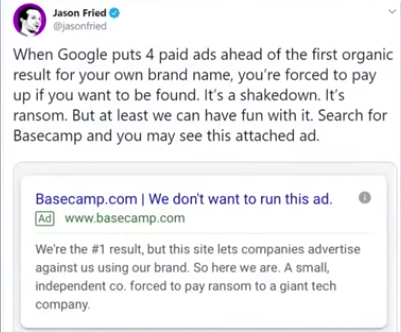How To Be Proactive When It Comes To Protecting Your Brand Name On Paid Search
Have you heard the drama going on between Google and Basecamp CEO, Jason Fried? If not, watch this video to get caught up.
The basic gist is that Fried found competitors bidding on Basecamp’s trademark. Because of this, the competitors’ ads were appearing above Basecamp’s organic results. Fried took to Twitter to share his frustration.

Here’s what Basecamp should have done instead….protect their brand.
Here’s the deal—if you have a brand worth protecting, competitors are already bidding on your brand name. Some bid directly on your name, while others will bid on obvious brand-plus derivatives.
If you focus on protecting branded campaigns, it will lead to less competition and lower campaign costs.
While it’s a simple process to understand, brand protection requires considerable skill to actually catch advertisers bidding on your brand, prove that it’s happening, and then deal with the brand bidders appropriately. The response to competitive brand bidding can take several forms, from fighting back with your own brand bidding to getting the engines to remove the ad (if it breaks their rules), to legal action.
You can automate this process by adding your trademark, brand and product keywords into The Search Monitor tool and creating alerts for when violations appear. You’ll get a screenshot of the search result, along with the location, time and date of the search. This provides the necessary evidence to contact the violators to take down these ads, or to contact the engines themselves. You can even auto-submit violations to the search engines.
Bottom Line
The search landscape is competitive and brand bidding and trademark violations are part of that. While it may not seem “fair”, it’s better to be proactive in protecting your brand rather than just hoping it will stop. If you want to learn how to protect your brand in paid search, let us know. You can also download our guide to PPC Brand Protection.







 Brand Protection
Brand Protection SEM Insights
SEM Insights Affiliate Compliance
Affiliate Compliance Ad Armor
Ad Armor Learning Center
Learning Center Guides & Webinars
Guides & Webinars We Love Data™
We Love Data™ About Us
About Us Our Data
Our Data Careers
Careers Our Team
Our Team News
News Contact Us
Contact Us

